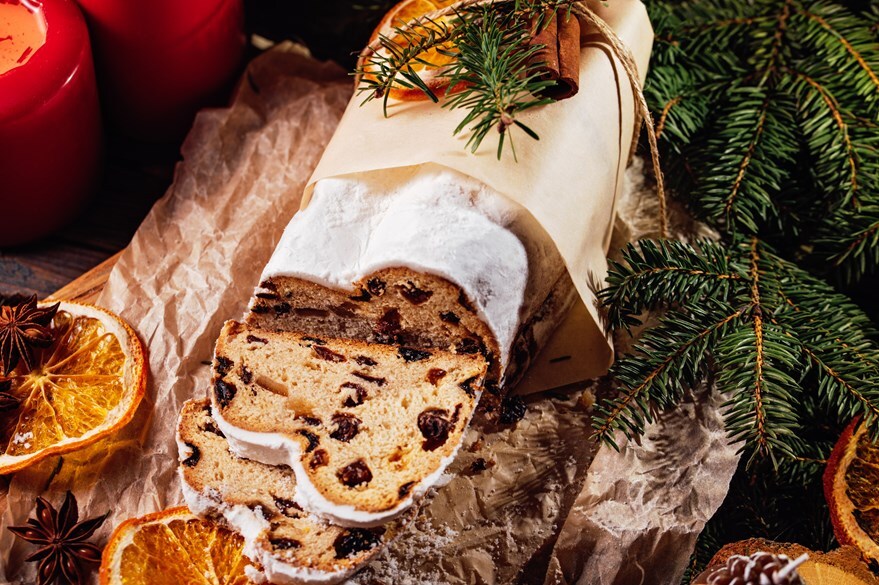Regal endorsements, religious rules and centuries of development have transformed many of the festive desserts of Europe into the sweet delights we are able to enjoy today.
Spoons at the ready as we dig into the fascinating past and fun traditions of some of the best-loved festive treats in the world, across Germany, Italy, Belgium and the UK.
Germany’s Weihnachtsstollen
Every Christmas, Germans end the day indulging in the dense fruit bread Stollen, packed full of spices, nutty marzipan and boozy raisins and dusted with icing sugar. Germans living within the Holy Roman Empire centuries ago, however, were not treated to such a delicacy.
When it was first introduced as a Christmas bread in the 1400s, Stollen had to abide by the strict rules of Advent imposed by the papacy. This meant no butter, sugar or alcohol. In fact, if you lived in 15th century Hamburg, the only ingredients you could use were flour, oil and yeast, leading to a rather austere dessert.
The Saxon nobility implored five successive Popes to allow the use of butter in the bread until eventually Pope Innocent VIII agreed in 1490. Centuries of improvement since then mean the bread has been perfected into the sweet success we eat today.

Italy's Panettone
Every Christmas, Germans end the day indulging in the dense fruit bread Stollen, packed full of spices, nutty marzipan and boozy raisins and dusted with icing sugar. Germans living within the Holy Roman Empire centuries ago, however, were not treated to such a delicacy.
When it was first introduced as a Christmas bread in the 1400s, Stollen had to abide by the strict rules of Advent imposed by the papacy. This meant no butter, sugar or alcohol. In fact, if you lived in 15th century Hamburg, the only ingredients you could use were flour, oil and yeast, leading to a rather austere dessert.
The Saxon nobility implored five successive Popes to allow the use of butter in the bread until eventually Pope Innocent VIII agreed in 1490. Centuries of improvement since then mean the bread has been perfected into the sweet success we eat today.
The UK's Figgy Pudding
A dessert to sing about, British people will often erupt into a rendition of the English Christmas carol, We Wish You a Merry Christmas, in anticipation of the arrival of the Figgy Pudding covered in brandy and ceremoniously set alight.
First invented in the 14th century, then with more of a soup-like consistency, the pudding has developed over the years into the cannonball-shaped, moist dessert filled with raisins and molasses, soaked in rum or brandy.
Initially a controversial pudding, it was banned by Puritans in 1664 as sinful, likely due to the copious amount of liquor used. Fortunately, in 1714 King George I brought it back and now you can enjoy it without repercussions. The only thing you need to watch out for today is the penny, hidden in the cake for good luck.
Belgium's Buche de Noel
Designed in the shape of a Yule log, this chocolate roulade, often elaborately decorated with cranberries, pinecones and edible flowers is the centrepiece of Christmas tables across France, Belgium and other French-speaking countries, but the cake’s origins can actually be traced back to the ancient Celts.
In celebration of the Winter Solstice, families would burn an enormous log on the shortest day of the year. The ritual promised a good crop at next year's harvest for some, the power to banish evil spirits, for others.
This long-held tradition lasted into the 19th century until the diminishing presence of large fireplaces in homes meant the log was brought to the table. In 1870, a Parisian pastry chef had a stroke of genius: why not make the Yule log edible? Thus, the Buche de Noel was born.
From Munich to Berlin, Rome to London, follow the scent of freshly baked festive treats and at the restaurants of Rocco Forte Hotels and discover Europe’s finest Christmas traditions.
You may also like
The Art of Cocktail Couture: Introducing Aquazzura Bar
Sometimes, the best ideas start in the most unexpected places. Often as a conversation between friends, perhaps over a drink. And so it was for Lydia Forte and Edgardo Osorio, Founder and Creative Director of Aquazzura whose shared vision led to the creation of Aquazzura Bar, a seasonal cocktail bar in the Secret Garden of Hotel de Russie. We sat down with them over a Margarita – what else? – to find out more…
Eating Well, Living Well: The Mediterranean Diet
Along the Mediterranean, food is intrinsic to daily life. Mornings begin with fishermen hauling in their catch, while market stalls brim with sun-ripened produce. Meals unfold slowly, often outdoors, with dishes meant to be shared. No rush, no excess - just ingredients at their peak, prepared simply and enjoyed in good company.
Edinburgh’s best distilleries, one dram at a time
To visit Scotland without sampling its whisky is to miss out on a defining feature of its heritage. From historic distilleries to the contemporary innovators bringing fresh perspectives to the craft, for guests of The Balmoral, the city’s whisky scene is waiting to be explored. Here’s where to start…